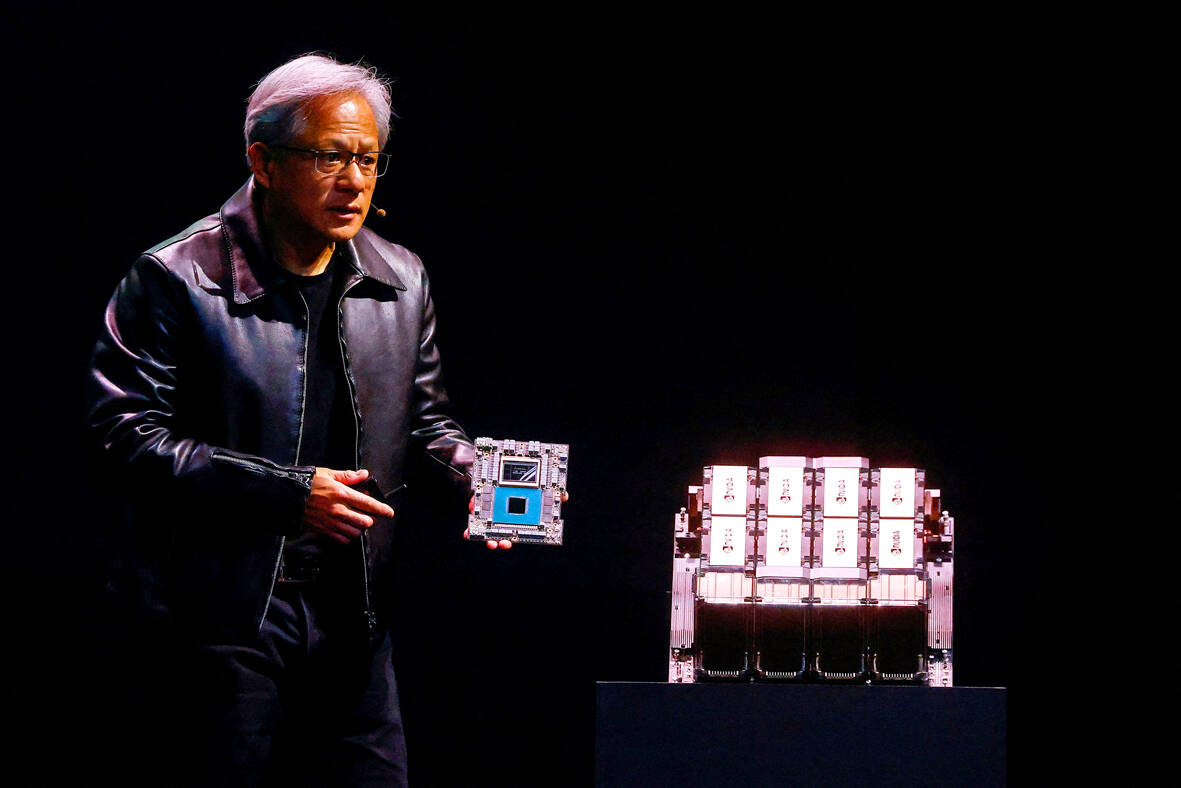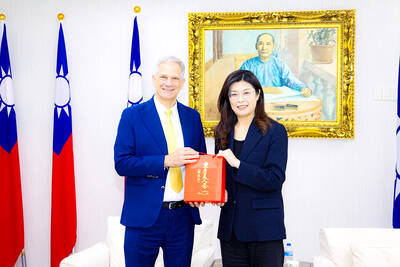When the pandemic forced Nvidia Corp to hold a major product launch virtually, CEO Jensen Huang (黃仁勳) beamed video to promote the event from his kitchen, where he pulled the company’s latest chip out of his oven.
“I’ve got something I’ve gotta show you,” Huang says while reaching for a pot holder. “This has been cooking for a while,” he says before grunting to lift a circuit board the size of a baking sheet from the oven to show “the world’s largest graphics card.”
That’s the type of showmanship that has turned the Taiwanese-American immigrant, who typically wears a black leather motorcycle jacket for product launches, into one of the best known names in the computing business.

Photo: Reuters
On Tuesday, he joined an elite list of tech executives to head a company worth US$1 trillion.
Huang, 60, is only the second US CEO after Amazon.com Inc’s Jeff Bezos, who helmed the retailer until 2021, to hit such a milestone for a company they co-founded.
FACE OF A COMPANY
There are few CEOs this side of late Apple Inc chief Steve Jobs who are so synonymous with their companies. Huang even has a tattoo inspired by Nvidia’s logo on one arm.
Nvidia chips have been at the heart of major tech tends from video games to self-driving cars, to cloud computing, and now artificial intelligence.
The company’s shares have been on a tear, rising on stellar sales projections from a boom in AI. Since the launch of OpenAI’s ChatGPT in November last year, Nvidia’s value has ballooned from roughly US$420 billion to its current level.
Huang’s success stems in part from a desire to solve thorny computer science problems with a mix of software and hardware — a vision that has taken him three decades to perfect.
Born in Taiwan, Huang moved to the US as a child, earning engineering degrees at Oregon State University and Stanford University.
ROCK STAR WELCOME
Huang is popular in semiconductor powerhouse Taiwan and received a rock star welcome during a visit to Taipei this week for a trade fair, giving a key note address on Monday attended by thousands of people, some of whom surrounded him for selfies after his two-hour speech.
In 1993, when he was 30, he founded Nvidia along with Curtis Priem and Chris Malachowsky, securing backing from Silicon Valley’s Sequoia Capital and others. Its first big hits were specialized chips to power high-intensity motion graphics for computer games called graphics processing units (GPUs). Even then, Huang did not think of Nvidia as just a chip company.
“Computer graphics is one of the most complex parts of computer science,” Huang told an audience in Silicon Valley in 2021 while receiving a lifetime achievement award. “You have to understand everything.”
By the mid-2000s, Huang and his team realized Nvidia’s chips could be used on more general computing problems and released a software platform called CUDA to allow software developers of all stripes to program Nvidia chips.
AN EARLY BET
That kicked off of a wave of new uses, including for cryptocurrency. But Huang recognized that university labs were using his chips for work in AI, a niche in computer science that held promise of powering everything from virtual assistants to self-driving cars. He released a parade of chips for AI, and the bet paid off.
Nvidia also differentiated itself by outsourcing its silicon manufacturing to partners including Taiwan Semiconductor Manufacturing, bucking the model set by Intel, which is now worth a fraction of Nvidia’s value — which was just under US$1 trillion as of Tuesday’s close.
“He has helped enable a revolution that allows phones to answer questions out loud, farms to spray weeds but not crops, doctors to predict the properties of new drugs — with more wonders to come,” AI entrepreneur Andrew Ng wrote of Huang in Time magazine when the latter was named one of the 100 most influential people by Time in 2021.

Seven hundred job applications. One interview. Marco Mascaro arrived in Taiwan last year with a PhD in engineering physics and years of experience at a European research center. He thought his Gold Card would guarantee him a foothold in Taiwan’s job market. “It’s marketed as if Taiwan really needs you,” the 33-year-old Italian says. “The reality is that companies here don’t really need us.” The Employment Gold Card was designed to fix Taiwan’s labor shortage by offering foreign professionals a combined resident visa and open work permit valid for three years. But for many, like Mascaro, the welcome mat ends at the door. A

Divadlo feels like your warm neighborhood slice of home — even if you’ve only ever spent a few days in Prague, like myself. A projector is screening retro animations by Czech director Karel Zeman, the shelves are lined with books and vinyl, and the owner will sit with you to share stories over a glass of pear brandy. The food is also fantastic, not just a new cultural experience but filled with nostalgia, recipes from home and laden with soul-warming carbs, perfect as the weather turns chilly. A Prague native, Kaio Picha has been in Taipei for 13 years and

Since Cheng Li-wun (鄭麗文) was elected Chinese Nationalist Party (KMT) chair on Oct. 18, she has become a polarizing figure. Her supporters see her as a firebrand critic of the ruling Democratic Progressive Party (DPP), while others, including some in her own party, have charged that she is Chinese President Xi Jinping’s (習近平) preferred candidate and that her election was possibly supported by the Chinese Communist Party’s (CPP) unit for political warfare and international influence, the “united front.” Indeed, Xi quickly congratulated Cheng upon her election. The 55-year-old former lawmaker and ex-talk show host, who was sworn in on Nov.

Even the most casual followers of Taiwan politics are familiar with the terms pan-blue and pan-green. The terms are used so casually and commonly with the assumption that everyone knows what they mean, that few stop to really question it. The way these terms are used today is far broader and extensive than what they were originally created to represent. Are these still useful shorthand terms, or have people become so obsessed with them that they color perceptions to the point of distortion? LEE TUNG-HUI WAS NO SMURF People often assume that these terms have been around forever, or at least as